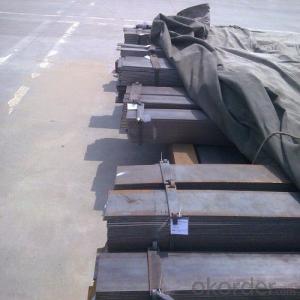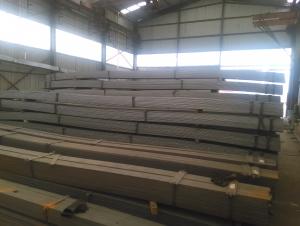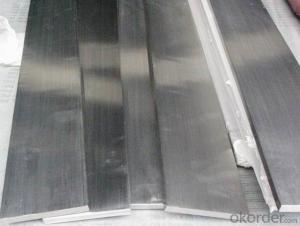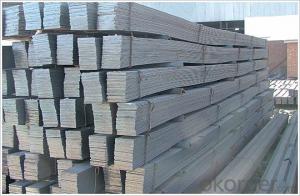Hot Rolled Flat Bar with Material Grade Q235
- Loading Port:
- Tianjin
- Payment Terms:
- TT OR LC
- Min Order Qty:
- 25 m.t.
- Supply Capability:
- 10000 m.t./month
OKorder Service Pledge
OKorder Financial Service
You Might Also Like
OKorder is offering high quality Flat Bar at great prices with worldwide shipping. Our supplier is a world-class manufacturer of steel, with our products utilized the world over. OKorder annually supplies products to European, North American and Asian markets. We provide quotations within 24 hours of receiving an inquiry and guarantee competitive prices.
Product Applications:
Slit Cutting Flat Bars are ideal for structural applications and are widely used in the construction of buildings and bridges, and the manufacturing, petrochemical, and transportation industries.
Product Advantages:
OKorder's Flats Bars are durable, strong, and resist corrosion.
Main Product Features:
· Premium quality
· Prompt delivery & seaworthy packing (30 days after receiving deposit)
· Corrosion resistance
· Can be recycled and reused
· Mill test certification
· Professional Service
· Competitive pricing
Product Specifications:
Manufacture: Hot Rolled
Grade: Q195 – 235
Certificates: ISO, SGS, BV, CIQ
Length: 6m – 12m, as per customer request
Packaging: Export packing, nude packing, bundled
Chemical composition of Q235
Alloy No | Grade | Element(%) | ||||
C
| Mn
| S
| P
| Si
| ||
Q235
|
B
|
0.12—0.20 |
0.3—0.7 |
≤0.045 |
≤0.045
|
≤0.3
|
Physical properties of Q235
Alloy No | Grade | Yielding strength point(Mpa) | Tensile strength (Mpa) | Elongation after fracture(%) | ||||||
Thickness (mm) | Thickness (mm) | |||||||||
≤16 | >16--40 | >40--60 | >60--100 | ≤16 | >16--40 | >40--60 | >60--100 | |||
≥ | ≥ | |||||||||
Q235 |
B |
235 |
225 |
215 |
205 |
375--500 |
26 |
25 |
24 |
23 |
FAQ:
Q1: How soon can we receive the product after purchase?
A1: Within three days of placing an order, we will begin production. The specific shipping date is dependent upon international and government factors, but is typically 7 to 10 workdays.
Q2: How do we guarantee the quality of our products?
A2: We have established an advanced quality management system which conducts strict quality tests at every step, from raw materials to the final product. At the same time, we provide extensive follow-up service assurances as required.
Q3: The products are invoicing on theoritical weight or on actual weight?
A3: We can do it in both manners, according to the customers' request.
Images:
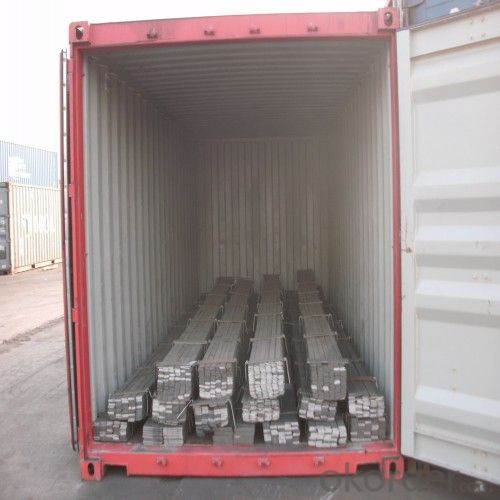
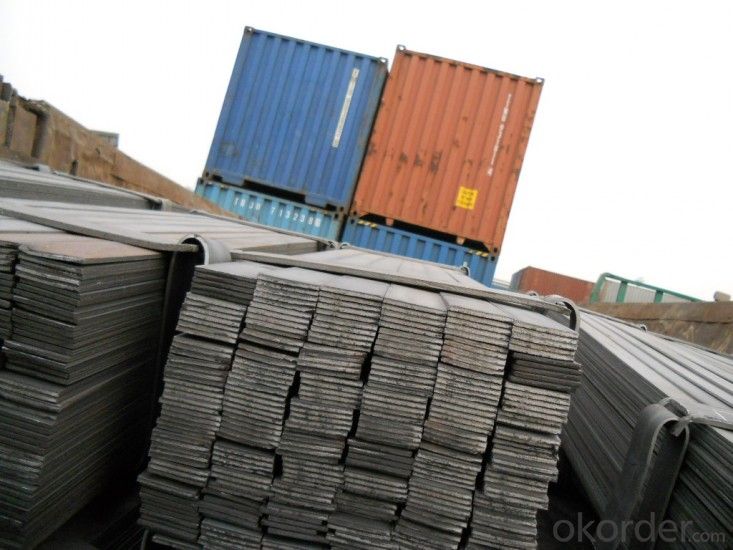
- Q:Are steel flat bars suitable for making toolboxes?
- Indeed, toolboxes can be constructed using steel flat bars. Steel, being a material that is both durable and strong, is well-suited for this purpose, as it allows the toolboxes to endure heavy loads while effectively safeguarding the tools. By conveniently welding steel flat bars together, a robust and dependable structure for the toolbox can be effortlessly formed. Furthermore, the corrosion resistance of steel proves advantageous, particularly for toolboxes that may encounter moisture or harsh surroundings. In summary, the utilization of steel flat bars is a dependable and pragmatic option when crafting toolboxes.
- Q:How do steel flat bars compare to rubber flat bars?
- Steel flat bars and rubber flat bars have different properties and uses, making them suitable for different applications. Steel flat bars are typically made from high-quality steel and are known for their strength and durability. They have excellent load-bearing capacity and can withstand heavy weights and pressure. Steel flat bars are commonly used in construction, manufacturing, and engineering industries where strength and stability are essential. They are also resistant to corrosion, making them suitable for outdoor applications. On the other hand, rubber flat bars are made from synthetic rubber compounds and are known for their flexibility and shock-absorbing properties. They are primarily used in applications where vibration reduction, impact resistance, or cushioning is required. Rubber flat bars are commonly used in industries such as automotive, machinery, and transportation, where they can absorb impacts and reduce noise and vibrations. In terms of cost, steel flat bars are generally more expensive than rubber flat bars due to the higher cost of steel production. However, steel flat bars are also more durable and have a longer lifespan, making them a cost-effective choice in the long run. Overall, the choice between steel flat bars and rubber flat bars depends on the specific requirements of the application. If strength, durability, and load-bearing capacity are crucial, steel flat bars are the preferred choice. However, if flexibility, shock absorption, and vibration reduction are essential, rubber flat bars are the better option.
- Q:How do steel flat bars contribute to the overall efficiency of industrial structures?
- Steel flat bars contribute to the overall efficiency of industrial structures in several ways. First and foremost, their durability and strength make them an ideal choice for structural components. Steel flat bars are known for their high tensile strength, which means they can withstand heavy loads and provide structural stability. This strength allows for the construction of taller and more complex industrial structures that can house various equipment and machinery. Furthermore, steel flat bars are highly versatile and can be easily fabricated, cut, and welded to fit specific design requirements. This flexibility enables engineers and architects to create customized industrial structures that maximize space utilization and optimize workflow. Whether used as support beams, braces, or reinforcements, steel flat bars can be tailored to meet the specific needs of a project, reducing construction time and costs. In addition, steel flat bars are resistant to corrosion and can withstand extreme weather conditions, making them suitable for both indoor and outdoor industrial structures. This resistance ensures longevity and reduces the need for frequent maintenance, saving both time and money in the long run. Moreover, steel flat bars are readily available and cost-effective compared to other materials. Their widespread availability and standardized sizes make procurement and construction processes more efficient, resulting in shorter lead times. This accessibility also allows for easy repairs and modifications, ensuring that industrial structures can adapt to changing needs and technologies without significant disruptions. Overall, steel flat bars contribute to the efficiency of industrial structures by providing strength, versatility, durability, and cost-effectiveness. Their usage enhances the structural integrity of buildings, optimizes space utilization, reduces maintenance requirements, and allows for easy customization. As a result, steel flat bars play a crucial role in the construction of efficient and reliable industrial structures.
- Q:What is the maximum temperature that steel flat bars can withstand?
- The maximum temperature endurance of steel flat bars relies on several factors, including the type of steel, its composition, and the intended usage. In general, most steel flat bars can endure temperatures ranging from 600-900 degrees Celsius (1100-1650 degrees Fahrenheit) without experiencing significant deformation or loss of structural integrity. Nevertheless, it is essential to refer to the manufacturer's specifications or engineering standards for precise information on the maximum temperature tolerance of a specific steel flat bar. Moreover, the duration of exposure to high temperatures can impact the maximum temperature endurance of steel flat bars. Sustained exposure to extreme temperatures can diminish strength and potentially lead to failure. Consequently, it is vital to consider the intended usage and adhere to industry guidelines to ensure the safe and effective utilization of steel flat bars under elevated temperatures.
- Q:How long do steel flat bars typically last?
- Steel flat bars typically last for a very long time due to their durability and resistance to corrosion. The lifespan of steel flat bars largely depends on the conditions they are exposed to and the level of maintenance they receive. In general, when properly maintained and protected from moisture and harsh elements, steel flat bars can last for several decades or even longer. However, if exposed to corrosive environments or neglected in terms of maintenance, their lifespan may be significantly reduced. Additionally, factors such as the quality of the steel, the specific alloy used, and the load or stress the flat bars are subjected to can also influence their longevity. It is important to regularly inspect and maintain steel flat bars to ensure their optimal lifespan and performance.
- Q:Can steel flat bars be used for making handrails or guardrails?
- Yes, steel flat bars can be used for making handrails or guardrails. Steel flat bars are often chosen for these applications due to their durability, strength, and versatility. They can be easily shaped and welded to create sturdy and reliable handrails or guardrails for various structures, such as staircases, balconies, or walkways.
- Q:How do steel flat bars perform in terms of thermal expansion?
- Steel flat bars have a relatively low coefficient of thermal expansion, meaning they expand and contract less compared to other materials when exposed to temperature changes. This makes them highly stable and resistant to warping or distortion due to thermal effects.
- Q:How do you prevent scaling or oxidation on steel flat bars during heat treatment?
- To prevent scaling or oxidation on steel flat bars during heat treatment, there are several measures that can be taken: 1. Utilize a protective atmosphere: An effective method involves subjecting the steel flat bars to heat treatment in a controlled atmosphere, such as vacuum or an inert gas environment like nitrogen or argon. This approach ensures that the steel remains isolated from oxygen, thereby minimizing the potential for oxidation. 2. Employ a protective coating: Another approach is to apply a protective coating onto the flat bars' surface prior to heat treatment. This can be accomplished by utilizing various coatings like ceramic, refractory, or metallic coatings. These coatings serve as a barrier between the steel and the surrounding atmosphere, effectively preventing oxidation. 3. Implement a reducing atmosphere: Heat treating the steel in a reducing atmosphere, such as hydrogen or a hydrogen-nitrogen mixture, can also prevent scaling and oxidation. The reducing atmosphere aids in eliminating any present oxygen and inhibits the formation of oxides on the steel's surface. 4. Control the heating process: The proper control of the heating process plays a crucial role in preventing scaling and oxidation. It is important to avoid rapid heating and cooling rates, as they can result in excessive scaling. Instead, employing slow and controlled heating with appropriate temperature ramping can help minimize the likelihood of oxidation. 5. Ensure surface cleanliness: Before heat treatment, it is essential to thoroughly clean the surface of the steel flat bars. Any contaminants, such as dirt, grease, or oils, can contribute to scaling and oxidation. Employing surface cleaning methods like degreasing, pickling, or mechanical cleaning can effectively eliminate these contaminants. By implementing these preventive measures, the risk of scaling or oxidation on steel flat bars during heat treatment can be significantly reduced, thereby ensuring the production of high-quality final products.
- Q:What are steel flat bars?
- Steel flat bars, characterized by their long rectangular shape, flat surface, and sharp edges, are commonly utilized in construction, manufacturing, and industrial sectors. These bars are manufactured using different grades of steel, such as carbon steel or stainless steel, and are produced through the processes of hot rolling or cold drawing. Due to their versatility and strength, steel flat bars find a wide range of applications. They are frequently employed as structural supports, braces, or framing components in buildings and bridges. In the manufacturing field, they serve as base plates for machinery, brackets, or raw material for fabrication. Furthermore, the automotive, aerospace, and marine industries also heavily rely on steel flat bars. The flat surface of these bars enables easy welding, cutting, and machining, making them highly adaptable for diverse projects and applications. They can be easily shaped, bent, or drilled to meet specific requirements. The sharp edges of steel flat bars also provide stability and structural support when used in construction or as load-bearing elements. Steel flat bars are available in various sizes, thicknesses, and lengths, allowing for customization and flexibility in their usage. They are typically found in standard dimensions and can be purchased from steel suppliers or metal fabrication shops. In conclusion, steel flat bars are indispensable building materials that offer strength, durability, and versatility. Their extensive use in various industries and applications makes them a critical component in numerous construction and manufacturing projects.
- Q:What are the different types of surface defects in copper steel flat bars?
- There are several different types of surface defects that can occur in copper steel flat bars. Some of the most common defects include: 1. Scratches: These are linear marks on the surface of the bar caused by contact with another object. Scratches can vary in depth and severity, ranging from superficial marks to deeper grooves. 2. Pitting: Pitting refers to small, localized holes or depressions on the surface of the bar. It is typically caused by corrosion or chemical reactions, and can affect the appearance and structural integrity of the bar. 3. Roll marks: Roll marks are irregular patterns or lines on the surface of the bar that result from the manufacturing process. They are caused by the rolling mills used to shape the bar, and can vary in size and intensity depending on the specific rolling technique employed. 4. Scale: Scale is a layer of oxide that forms on the surface of the copper steel flat bar during the heating or cooling process. It appears as a dark, rough coating that can be flaky or adherent. Scale can affect the surface finish and may need to be removed before further processing or use. 5. Inclusions: Inclusions are foreign particles or impurities that become trapped within the metal during the manufacturing process. They can appear as dark spots or irregularities on the surface of the bar and may affect the mechanical properties of the material. 6. Edge cracks: Edge cracks are small, hairline fractures that occur along the edges of the bar. They can be caused by improper handling, excessive stress, or manufacturing defects. Edge cracks can compromise the structural integrity of the bar and may require repair or replacement. It is important to note that these surface defects can vary in severity and frequency depending on the quality of the manufacturing process and the specific application of the copper steel flat bars. Regular inspection and quality control measures are necessary to identify and address these defects to ensure the desired performance and longevity of the bars.
1. Manufacturer Overview |
|
|---|---|
| Location | |
| Year Established | |
| Annual Output Value | |
| Main Markets | |
| Company Certifications | |
2. Manufacturer Certificates |
|
|---|---|
| a) Certification Name | |
| Range | |
| Reference | |
| Validity Period | |
3. Manufacturer Capability |
|
|---|---|
| a)Trade Capacity | |
| Nearest Port | |
| Export Percentage | |
| No.of Employees in Trade Department | |
| Language Spoken: | |
| b)Factory Information | |
| Factory Size: | |
| No. of Production Lines | |
| Contract Manufacturing | |
| Product Price Range | |
Send your message to us
Hot Rolled Flat Bar with Material Grade Q235
- Loading Port:
- Tianjin
- Payment Terms:
- TT OR LC
- Min Order Qty:
- 25 m.t.
- Supply Capability:
- 10000 m.t./month
OKorder Service Pledge
OKorder Financial Service
Similar products
New products
Hot products
Related keywords
